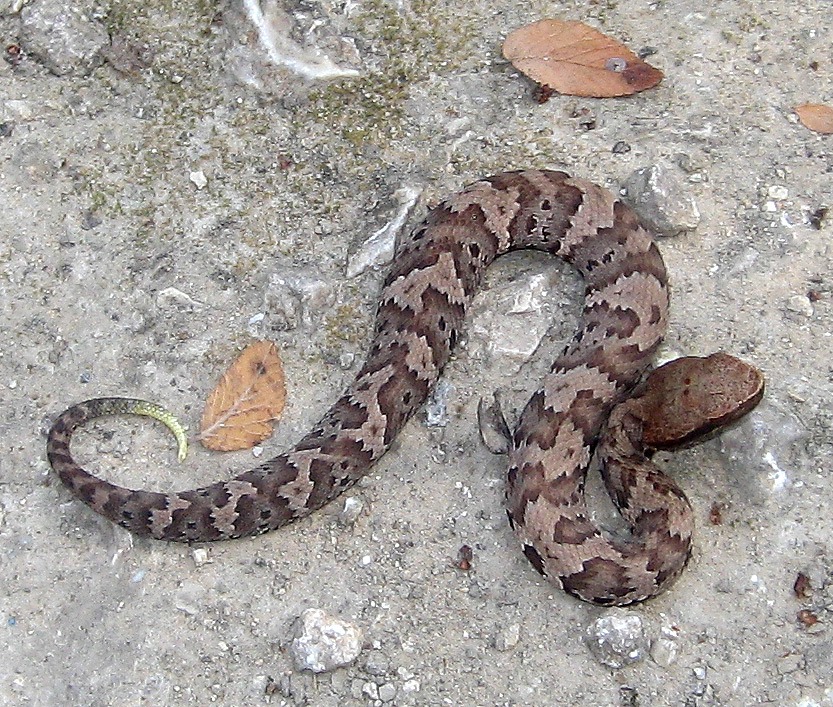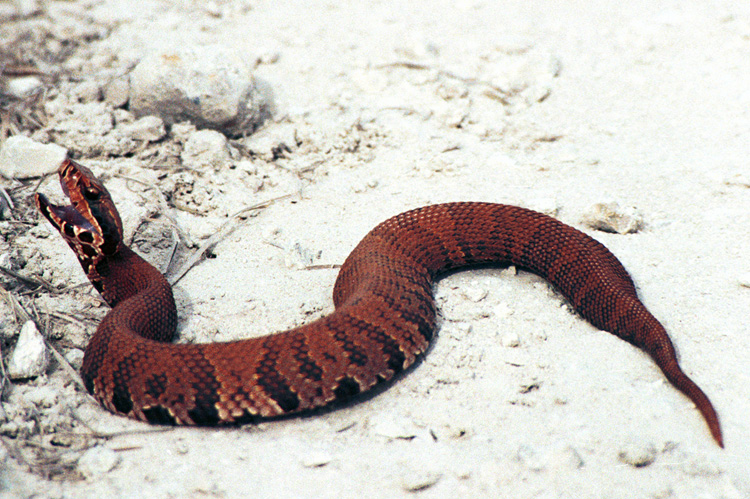|
Cottonmouth
''Agkistrodon piscivorus'' is a species of venomous snake, a pit viper in the subfamily Crotalinae of the family Viperidae. It is one of the world's few semiaquatic vipers (along with the Florida cottonmouth), and is native to the Southeastern United States. As an adult, it is large and capable of delivering a painful and potentially fatal bite. When threatened, it may respond by coiling its body and displaying its fangs. Individuals may bite when feeling threatened or being handled in any way. It tends to be found in or near water, particularly in slow-moving and shallow lakes, streams, and marshes. It is a capable swimmer, and like several species of snakes, is known to occasionally enter bays and estuaries and swim between barrier islands and the mainland. Gloyd HK, Conant R (1990). ''Snakes of the ''Agkistrodon'' Complex: A Monographic Review''. Society for the Study of Amphibians and Reptiles. 614 pp. 52 plates. LCCN 89-50342. . The generic name is derived from the Gree ... [...More Info...] [...Related Items...] OR: [Wikipedia] [Google] [Baidu] |
Florida Cottonmouth
The Florida cottonmouth (''Agkistrodon conanti'') is a species of venomous snake, a pit viper in the subfamily Crotalinae of the Family (biology), family Viperidae. The species is Endemism, endemic to the United States, where it occurs in southern Georgia (U.S. state), Georgia and the Florida peninsula in nearly every type of wetlands in the region, including brackish water and offshore islands. However, it is not entirely dependent on water and is occasionally encountered as far as a mile (1.6 km.) from surface water. ''Agkistrodon conanti'' venom is very hemolytic and known to cause relatively extensive necrosis compared to many snake venoms, and can sometimes be lethal with a 17% mortality rate.species:Carl H. Ernst, Ernst CH, species:Evelyn M. Ernst, Ernst EM (2011). ''Venomous Reptiles of the United States, Canada, and Northern Mexico, Volume 1: ''Heloderma, Micruroides, Micrurus, Pelamis, Agkistrodon, Sistrurus. Baltimore: The Johns Hopkins University Press. xviii + 352 pp. ... [...More Info...] [...Related Items...] OR: [Wikipedia] [Google] [Baidu] |
Venomous Snake
''Venomous snakes'' are species of the suborder Serpentes that are capable of producing venom, which they use for killing prey, for defense, and to assist with digestion of their prey. The venom is typically delivered by injection using hollow or grooved fangs, although some venomous snakes lack well-developed fangs. Common venomous snakes include the families Elapidae, Viperidae, Atractaspididae, and some of the Colubridae. The toxicity of venom is mainly indicated by murine , while multiple factors are considered to judge the potential danger to humans. Other important factors for risk assessment include the likelihood that a snake will bite, the quantity of venom delivered with the bite, the efficiency of the delivery mechanism, and the location of a bite on the body of the victim. Snake venom may have both neurotoxic and hemotoxic properties. There are about 600 venomous snake species in the world. Evolution The evolutionary history of venomous snakes can be traced back ... [...More Info...] [...Related Items...] OR: [Wikipedia] [Google] [Baidu] |
Pit Viper
The Crotalinae, commonly known as pit vipers,Mehrtens JM (1987). ''Living Snakes of the World in Color''. New York: Sterling Publishers. 480 pp. . or pit adders, are a subfamily (biology), subfamily of Viperidae, vipers found in Asia and the Americas. Like all other vipers, they are venomous snake, venomous. They are distinguished by the presence of a Infrared sensing in snakes, heat-sensing pit organ located between the eye and the nostril on both sides of the head. Currently, 23 genus, genera and 155 species are recognized: These are also the only Viperidae, viperids found in the Americas. The groups of snakes represented here include rattlesnakes, Bothrops, lanceheads, and Trimeresurus, Asian pit vipers. The type genus for this subfamily is ''Crotalus'', of which the type species is the timber rattlesnake, ''C. horridus''. These snakes range in size from the diminutive hump-nosed viper, ''Hypnale hypnale'', that grows to a typical total length (including tail) of only , to ... [...More Info...] [...Related Items...] OR: [Wikipedia] [Google] [Baidu] |
Pleistocene
The Pleistocene ( ; referred to colloquially as the ''ice age, Ice Age'') is the geological epoch (geology), epoch that lasted from to 11,700 years ago, spanning the Earth's most recent period of repeated glaciations. Before a change was finally confirmed in 2009 by the International Union of Geological Sciences, the cutoff of the Pleistocene and the preceding Pliocene was regarded as being 1.806 million years Before Present (BP). Publications from earlier years may use either definition of the period. The end of the Pleistocene corresponds with the end of the last glacial period and also with the end of the Paleolithic age used in archaeology. The name is a combination of Ancient Greek () 'most' and (; Latinized as ) 'new'. The aridification and cooling trends of the preceding Neogene were continued in the Pleistocene. The climate was strongly variable depending on the glacial cycle, oscillating between cold Glacial period, glacial periods and warmer Interglacial, int ... [...More Info...] [...Related Items...] OR: [Wikipedia] [Google] [Baidu] |
Piscivore
A piscivore () is a carnivorous animal that primarily eats fish. Fish were the diet of early tetrapod evolution (via water-bound amphibians during the Devonian period); insectivory came next; then in time, the more terrestrially adapted reptiles and synapsids evolved herbivory. Almost all predatory fish (most sharks, tuna, billfishes, pikes etc.) are obligated piscivores. Some non-piscine aquatic animals, such as whales, sea lions, and crocodilians, are not completely piscivorous; often also preying on invertebrates, marine mammals, waterbirds and even wading land animals in addition to fish, while others, such as the bulldog bat and gharial, are strictly dependent on fish for food. Some creatures, including cnidarians, octopuses, squid, cetaceans, spiders, grizzly bears, jaguars, wolves, snakes, turtles and sea gulls, may have fish as significant if not dominant portions of their diets. Humans can live on fish-based diets, as can their carnivorous domesticated pets su ... [...More Info...] [...Related Items...] OR: [Wikipedia] [Google] [Baidu] |
Scientific Name
In Taxonomy (biology), taxonomy, binomial nomenclature ("two-term naming system"), also called binary nomenclature, is a formal system of naming species of living things by giving each a name composed of two parts, both of which use Latin grammar, Latin grammatical forms, although they can be based on words from other languages. Such a name is called a binomial name (often shortened to just "binomial"), a binomen, name, or a scientific name; more informally, it is also called a Latin name. In the International Code of Zoological Nomenclature (ICZN), the system is also called nomenclature, with an "n" before the "al" in "binominal", which is a typographic error, meaning "two-name naming system". The first part of the name – the ''generic name (biology), generic name'' – identifies the genus to which the species belongs, whereas the second part – the specific name or specific epithet – distinguishes the species within the genus. For example, modern humans belong to the ... [...More Info...] [...Related Items...] OR: [Wikipedia] [Google] [Baidu] |
Latin
Latin ( or ) is a classical language belonging to the Italic languages, Italic branch of the Indo-European languages. Latin was originally spoken by the Latins (Italic tribe), Latins in Latium (now known as Lazio), the lower Tiber area around Rome, Italy. Through the expansion of the Roman Republic, it became the dominant language in the Italian Peninsula and subsequently throughout the Roman Empire. It has greatly influenced many languages, Latin influence in English, including English, having contributed List of Latin words with English derivatives, many words to the English lexicon, particularly after the Christianity in Anglo-Saxon England, Christianization of the Anglo-Saxons and the Norman Conquest. Latin Root (linguistics), roots appear frequently in the technical vocabulary used by fields such as theology, List of Latin and Greek words commonly used in systematic names, the sciences, List of medical roots, suffixes and prefixes, medicine, and List of Latin legal terms ... [...More Info...] [...Related Items...] OR: [Wikipedia] [Google] [Baidu] |
Specific Name (zoology)
In zoological nomenclature, the specific name (also specific epithet, species epithet, or epitheton) is the second part (the second name) within the scientific name of a species (a binomen). The first part of the name of a species is the name of the genus or the generic name. The rules and regulations governing the giving of a new species name are explained in the article species description. For example, the scientific name for humans is ''Homo sapiens'', which is the species name, consisting of two names: ''Homo'' is the " generic name" (the name of the genus) and ''sapiens'' is the "specific name". Etymology Historically, ''specific name'' referred to the combination of what are now called the generic and specific names. Carl Linnaeus, who formalized binomial nomenclature, made explicit distinctions between specific, generic, and trivial names. The generic name was that of the genus, the first in the binomial, the trivial name was the second name in the binomial, and the ... [...More Info...] [...Related Items...] OR: [Wikipedia] [Google] [Baidu] |
Greek Language
Greek (, ; , ) is an Indo-European languages, Indo-European language, constituting an independent Hellenic languages, Hellenic branch within the Indo-European language family. It is native to Greece, Cyprus, Italy (in Calabria and Salento), southern Albania, and other regions of the Balkans, Caucasus, the Black Sea coast, Asia Minor, and the Eastern Mediterranean. It has the list of languages by first written accounts, longest documented history of any Indo-European language, spanning at least 3,400 years of written records. Its writing system is the Greek alphabet, which has been used for approximately 2,800 years; previously, Greek was recorded in writing systems such as Linear B and the Cypriot syllabary. The Greek language holds a very important place in the history of the Western world. Beginning with the epics of Homer, ancient Greek literature includes many works of lasting importance in the European canon. Greek is also the language in which many of the foundational texts ... [...More Info...] [...Related Items...] OR: [Wikipedia] [Google] [Baidu] |
Genus
Genus (; : genera ) is a taxonomic rank above species and below family (taxonomy), family as used in the biological classification of extant taxon, living and fossil organisms as well as Virus classification#ICTV classification, viruses. In binomial nomenclature, the genus name forms the first part of the binomial species name for each species within the genus. :E.g. ''Panthera leo'' (lion) and ''Panthera onca'' (jaguar) are two species within the genus ''Panthera''. ''Panthera'' is a genus within the family Felidae. The composition of a genus is determined by taxonomy (biology), taxonomists. The standards for genus classification are not strictly codified, so different authorities often produce different classifications for genera. There are some general practices used, however, including the idea that a newly defined genus should fulfill these three criteria to be descriptively useful: # monophyly – all descendants of an ancestral taxon are grouped together (i.e. Phylogeneti ... [...More Info...] [...Related Items...] OR: [Wikipedia] [Google] [Baidu] |
Southeastern United States
The Southeastern United States, also known as the American Southeast or simply the Southeast, is a geographical List of regions in the United States, region of the United States located in the eastern portion of the Southern United States and the southern portion of the East Coast of the United States, Eastern United States. The region includes a core of states that reaches north to Maryland and West Virginia, bordering the Ohio River and Mason–Dixon line, and stretches west to Arkansas and Louisiana. There is no official Federal government of the United States, U.S. government definition for the region, and it is defined variably among agencies and organizations. History The history of the present-day Southeastern United States dates to the dawn of civilization in approximately 11,000 BC or 13,000 BC. The earliest artifacts from the region were from the Clovis culture. Prior to the arrival of Colonial history of the United States, European colonialists, Native Americans in ... [...More Info...] [...Related Items...] OR: [Wikipedia] [Google] [Baidu] |








